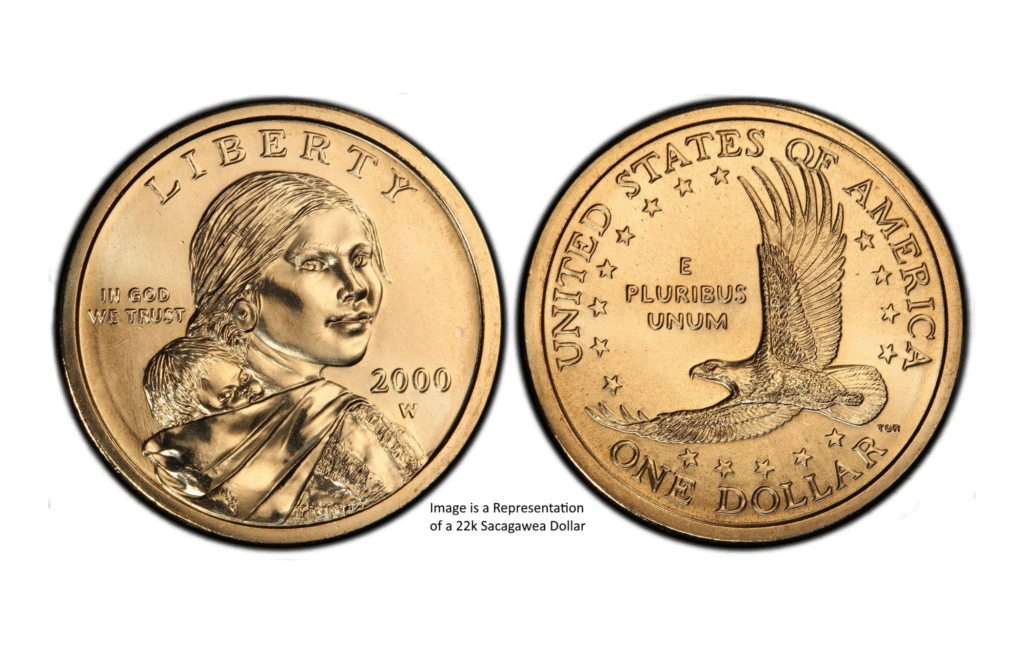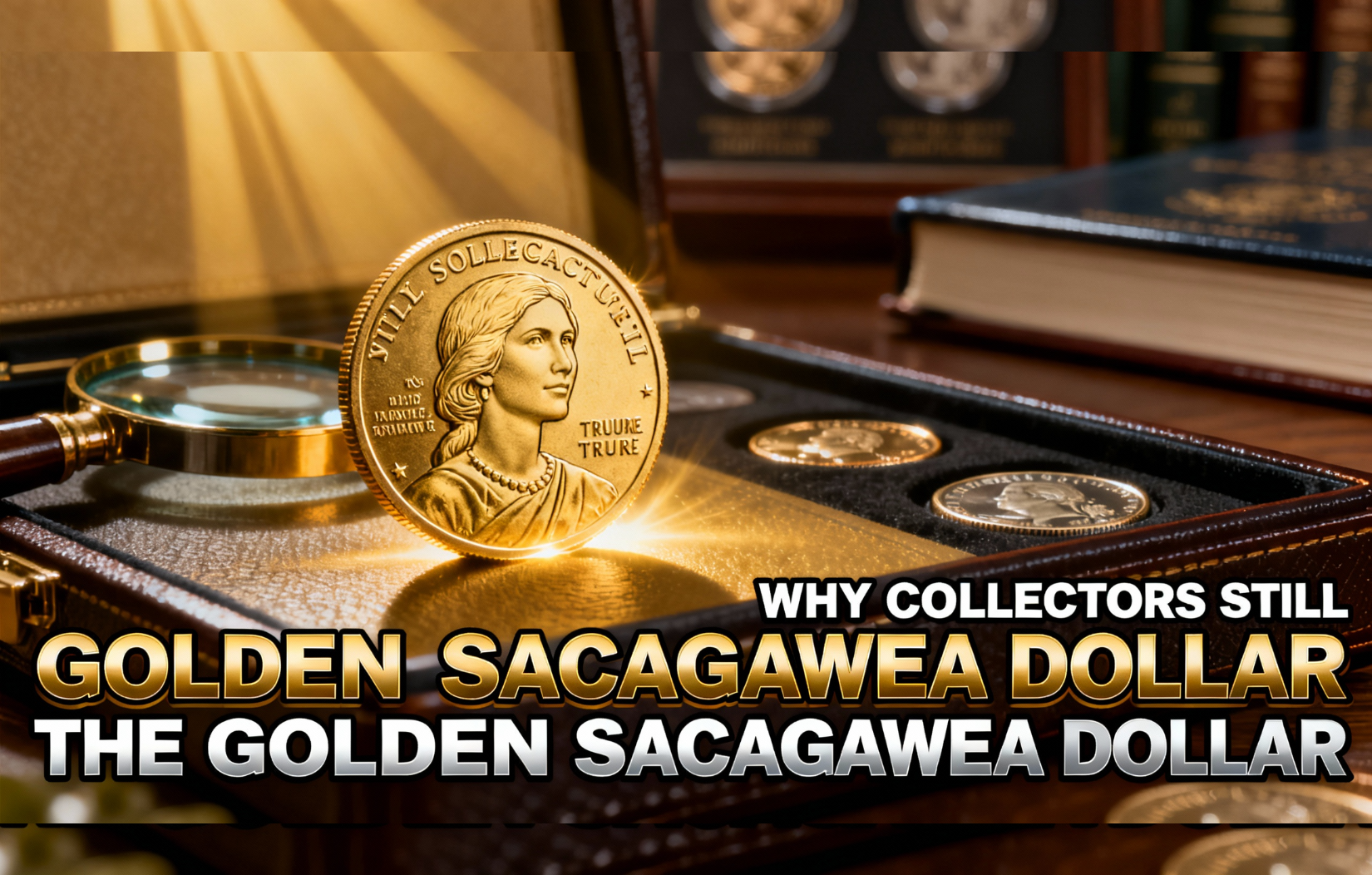What is the “Golden” Sacagawea Dollar
To understand the fascination, it helps to start with what the golden Sacagawea is:
- The Sacagawea dollar was introduced by the U.S. Mint in 2000. It replaced the Susan B. Anthony dollar, and one of its key selling points was its golden appearance. That golden color comes from a special manganese‑brass alloy (“outer layer of manganese brass” around a core), not from gold.
- The coin shows Sacagawea carrying her infant son, Jean Baptiste, on the obverse; the original reverse was an eagle in flight. Starting in 2009, the reverse design began changing annually under the Native American $1 Coin Program, but the obverse of Sacagawea remained.
- Because of the “golden” color, there has always been a bit of mystique, especially among casual coin collectors or people unfamiliar with coin‐metal compositions, about whether they might actually contain gold. Many “golden Sacagawea” coins do not contain precious metal; their value (unless rare variety or special issue) is more numismatic than intrinsic.
Recent Developments & Why Interest Is Peaking Now (2024‑2025)
In recent years, several events have revived or increased collector fascination with these coins, both the “regular” golden Sacagawea dollars and the rare special issues. Some of the significant developments are:
- 25th Anniversary Gold Proof Coin (24K, Half‑Ounce)
- In 2025, the U.S. Mint released a 24‑karat one half‑ounce gold proof coin to mark the 25th anniversary of the Sacagawea Golden Dollar design.
- This is a real gold coin (not just golden in color), struck as a collectible proof, limited edition. These “actual gold” Sacagawea pieces are rare, desirable, and bring a different class of collector (those who appreciate precious metals and limited mintage).
- Space‑Flown 22‑Karat Gold Sacagawea Dollars
- Even more exotic are the 2000‑W Sacagawea dollars struck in 22K gold that flew aboard the Space Shuttle Columbia in 1999. Only a small number were made, and fewer still are made available for public sale.
- In September 2025, Stack’s Bowers Galleries auctioned seven of these space‑flown gold proofs, plus the first‑struck 2025‑W 24K gold proof, with realized prices between approximately US$360,001 and US$550,001 for individual 22K pieces.
- Rare Errors / Varieties
- The Sacagawea dollar series has produced several error coins that are highly prized. Among the most famous is the 2000‑P Sacagawea / Washington quarter mule error, where the obverse from a Washington Quarter die was paired with the reverse of a Sacagawea dollar. Only a few such coins are known, and those tend to sell for large sums.
- In January 2024, one of these mule errors graded MS‑66 by PCGS achieved a selling price with buyer’s premium of US$194,062.50 in a GreatCollections auction. That set a record for that kind of error.
- Scarcity, Nostalgia, and Design
- Early Sacagawea dollars (2000‑2003) are particularly interesting because they represent the launch years—people often attribute more value (both monetary and sentimental) to “firsts.”
- Also, some special promotional issues (e.g. “Cheerios dollars” from 1999) or varieties (e.g. “Wounded Eagle”) have distinct traits (finely detailed tail feathers, etc.) which make certain coins more collectible.
Specific Notable Coins & Auction Highlights
To understand how serious the collector interest is, it helps to look at specific examples and what people are paying.

- Space‑flown 2000‑W 22K gold proofs: Auctioned in September 2025 by Stack’s Bowers Galleries. Seven such proofs realized between US$360,001 and US$550,001 each.
- 2025‑W 24K gold proof, 25th Anniversary, first struck piece: Realized around US$120,001 in that same auction.
- 2000‑P Sacagawea / Washington Quarter mule graded MS‑66 by PCGS: In Jan 2024, sold for nearly US$194,062.50 (including buyer’s premium).
- There are also reports of “found in change” coins, or coins in private collections / hoards, that turn out to be rare varieties, though many of these are unverified publicly. The “mule” error is among the most visible because it is well documented.
Why Collectors Are Drawn to the Golden Sacagawea Dollar
Putting together the above, here are the key pulls for collectors:
- Unique blend of aesthetics and novelty
- The golden color makes the coin visually distinct among U.S. circulating coinage. Even for those who know it’s not real gold, the look is appealing.
- For proof and special issues in actual gold, you get the combo of historic design + actual precious metal + rarity.
- Errors and rare varieties with high upside
- Coins like mule errors are exciting because they represent mistakes that slipped through—a mismatch of dies or a mis‑run that shouldn’t have happened. Those anomalies are limited in number and often highly visible.
- When such an error is authenticated and in very good grade (minimal wear, clear die features), the collector community charges up.
- Historical significance and symbolism
- The coin honors Sacagawea, a figure of Native American history, and the design is part of broader efforts to represent diversity in U.S. coinage.
- The “golden dollar” era marked a transition from Susan B. Anthony coins, and then further transitions (Native American $1 coins) later. This situates the design in a period of change.
- Limited special issues and provenance stories
- Space‑flown coins carry extra allure, because of the journey they made, their scarcity, and the story. A coin that has been in orbit is more than just metal—it’s part of space history.
- Anniversary issues in real gold, first‑struck pieces, mint director signatures or certificates of authenticity all add provenance, which greatly boosts collector confidence and value.
- Market forces & collector demand
- The coins are heavily collected; errors and special editions are widely covered in numismatic media, so demand is broad among error‑hunters, precious‑metal collectors, history buffs.
- Because many regular Sacagawea dollars were minted in large quantities and circulated, it’s unlikely new high‑value common coins will appear in bulk, which increases the relative rarity and value of special types.
- Legacy and nostalgia
- For many collectors who began collecting in early 2000s, the Sacagawea golden dollar is part of their youth or early collecting years. Those emotional connections push interest.
- The “golden” label adds glamour – people like coins that look special.
What to Watch Out For / What Determines Value

If you have a Sacagawea golden dollar (or think you might), here are the features that tend to matter most in distinguishing high‑value from regular:
- Which coin it is: Is it regular manganese‑brass Sacagawea, a proof, a coin in gold (anniversary edition, space‑flown, etc.), or an error?
- Condition / Grade: Mint State or Proof, with minimal wear. Deep cameo proofs are especially desirable for special issues. Sharp detail, no corrosion, original surfaces matter. Certification by PCGS, NGC etc. is key. For example, the space‑flown gold proofs were graded Proof‑69 Deep Cameo.
- Rarity / Mintage: How many were made, how many survive, how many are in collector hands. A coin that was never intended for public release (space flown, special set) will often have a lower surviving population. The 22K space‑flown coins are examples.
- Provenance / Certification: Coins with clear documentation of where they came from, especially for special issues (first strike, flown in space, etc.), do much better. Certificates of authenticity with signatures (e.g. mint director) help.
- Specific Errors / Varieties: Some are particularly sought after:
- Mule errors (e.g. quarter obverse + Sacagawea reverse) as mentioned.
- “Wounded Eagle” varieties, “Cheerios Dollars” (with early designs) etc.
- Limited Edition and Special Editions: Anniversary editions, gold versions, proof versions, especially those produced in small numbers.
Misconceptions & Things Collectors Should Be Careful With
Part of the interest in the “golden” Sacagawea comes from myth or misunderstanding. Some caution points:
- Just because a coin is golden in color doesn’t mean it’s valuable or contains gold. Many are just standard manganese‑brass. The special proof or gold coins are exceptional.
- Error claims can be overstated. Some “errors” are just wear, corrosion, or damage. Authentication matters, especially for high price claims.
- Market hype can push people to overpay or believe something rare when it’s not. Always check grade, population reports, previous auction results.
- Rarity does not guarantee value. Even among rare coins, condition, demand among collectors, and visibility (has it been publicized, verified?) influence value enormously.
The Long‑Term Perspective: What Makes This Line Likely to Remain Collectible
Looking forward, these are the reasons collectors believe the Golden Sacagawea Dollar will continue to hold intrigue:
- Historical and symbolic importance: The Sacagawea dollar marked a shift in U.S. coinage design (new materials, honoring Native American figures) and has cultural resonance.
- Continued production of special issues (proofs, anniversary gold editions) ensures there are always new “premium” items that draw attention.
- Collector awareness: Because of high profile auction sales and numismatic press coverage, more people know what to look for. That means more “finds,” more trading, more demand.
- Scarce artifacts (space‑flown coins, gold proofs, error coins) are unlikely to be reproduced or found in large numbers; existing specimens will only grow rarer as time passes.
- Good market liquidity for certain types: collectors of modern U.S. coins or error coins are active; there’s demand in auctions, coin shows; coins with proper proof and provenance tend to sell well.
Recent Auction & Market Data Summary (2025)
Here are a few of the most relevant recent results that illustrate how much serious collectors are paying:
- The space‑flown 22K gold Sacagawea proofs sold in September 2025 for US$360,000 to US$550,001 each. These are limited edition, extreme rarity pieces.
- The 2025‑W 24K gold 25th‑anniversary proof (first struck) sold for about US$120,001.
- The record “mule” error Sacagawea dollar / Washington quarter coin (2000‑P) graded MS‑66 sold for ~ US$194,062.50 in 2024.
These demonstrate that while the very top coins (errors, gold, flown coins) fetch hundreds of thousands, more common Sacagawea dollars—even in uncirculated condition—are nowhere near those values. The premium is heavily skewed toward rarity, provenance, special issue, and certification.
Conclusion
The Golden Sacagawea Dollar still fascinates collectors today because it sits at the intersection of design novelty, historical symbolism, rare accident/error possibilities, and specialized special issues. It isn’t just a coin with nostalgic or aesthetic value; there are segments within the series that are genuinely rare and valuable. The recent auctions of space‑flown gold examples and record sales of mule errors show that the collector market takes these seriously—and is willing to put up large sums for them.
If you have a Sacagawea golden dollar in hand, it’s worthwhile to examine it carefully (condition, mint mark, die variety, possible errors). Certified examples of rare types are the ones you’ll want to compare with recent public auction data. Over the long term, coins with the right combination of rarity + condition + story will likely only increase in both monetary and historic value.
FAQs
1. What is the “Golden” Sacagawea Dollar made of?
Despite its gold-like color, it’s made of a manganese-brass alloy—not real gold. It was introduced in 2000 and features Sacagawea with her infant son on the obverse.
2. Does the Golden Sacagawea Dollar contain actual gold?
No, most circulating Sacagawea dollars are golden-colored due to their alloy, not gold content. Only special editions, like the 2025 anniversary proof, are struck in real gold.
3. What is the 2025 Sacagawea gold coin?
To celebrate 25 years, the U.S. Mint released a limited-edition 24K gold proof Sacagawea dollar. It’s a true gold coin, not just golden-colored, and highly collectible.
